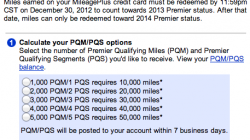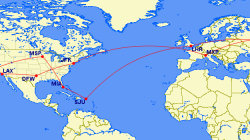Amol explained yesterday why he doesn’t think mileage runs are worthwhile. Sure, he enjoys the benefits of elite status. But he also doesn’t think flying just for the sake of flying is the best way to earn miles. One reason is that Amol flies on Delta, which has a unique loyalty program among domestic airlines. Before we get any further, let me remind you that miles fall into two groups: redeemable miles (RDMs) for buying award tickets and elite qualifying miles (EQMs) for earning elite status. EQMs can usually only be earned through travel, or very limited credit card promotions. RDMs can be earned through travel, elite bonuses, any credit card spend, and lots of other ways.
Delta SkyMiles Is a Unique Program
By using Delta credit cards, Amol can earn lots of EQMs (Delta calls them Medallion qualifying miles or MQMs) through credit card bonuses. He outlined one plan using a single card to get 15,000 EQMs and 60,000 RDMs, but that is hard to do with most other airlines. With additional Delta cards, he’d earn even more.
As a United traveler, I have a MileagePlus Select Visa that is no longer offered, but I keep paying the annual fee because I can get up to 10,000 EQMs each year. The first 5,000 EQMs are easy: buy $5,000 in airfare. I’ll also get 15,000 RDMs. The other 5,000 EQMs would require me to redeem 50,000 RDMs through United Choices. So while Amol’s strategy nets 15,000 EQMs and 60,000 RDMs, mine earns only 10,000 EQMs and loses 35,000 RDMs. And of course, I can only do this with a credit card no longer available to new customers.
If you’re an American Airlines customer, your luck is slightly better. The Executive AAdvantage WorldElite MasterCard has a $450 annual fee that includes an Admirals Club membership. Nothing special compared to the greater benefits of the American Express Platinum Card at the same price. However, the Executive AAdvantage card also offers 10,000 EQMs each year you spend $40,000, which might be helpful to some. Update: American Airlines and American Express will be ending their partnership as of March 22, 2014.
The second reason Delta is unique is that it allows rollover EQMs. If I fly 70,000 miles in a year on United, I get Gold status and the counter resets to zero. If Amol flies 70,000 miles in a year on Delta, he gets Gold status and has a 20,000-mile head start to requalifying the following year. He can strategically book cheap flights or long routings now and use those miles to earn status the following year instead. I have to start from scratch.
Why Do Mileage Runs?
If your preferred carrier isn’t Delta, then obtaining elite status is more likely to require actual time spent with your butt in a seat. You may fly a lot already as a business traveler or frequent leisure traveler. Most people are infrequent travelers, maybe two or three times a year, and I will address them at the end.
In my case, I am somewhere in between. I fly enough already to earn mid-tier status. I have flights to see my family on the West Coast, Megan’s family in Texas, and friends living on the East Coast. I have a little bit of work travel either in my previous position as a graduate student attending conferences or for what I do now, as a blogger attending some of the regular events like the MegaDO and Chicago Seminars.
When I first earned Premier 1K in 2011, all of this added up to 25,000 miles, which left me 75,000 short. In 2012, “necessary” travel reached 50,000 miles or more. In fact, Megan flies much less than I do but still managed to earn Premier Gold status entirely by accident (neither of us were tracking her balance). Those “necessary” flights are the more expensive ones because I don’t have much control over the location or the dates of travel.
I still do what I can to find a sale before booking. But since I’m already halfway to Premier 1K status, I only have to find 50,000 worth of unnecessary, superfluous mileage runs, usually at a cost of 4 cents per mile. That works out to $2,000 to close the gap between Gold status and 1K. Four cents per mile is by no means as easy to find as it once was, but it is readily available if you look early and often.
Valuing Mileage Runs
What do I get for $2,000? I dramatically improve my upgrade odds. Most of my travel is domestic and with a companion. Because of my status and United’s companion upgrade benefit, Megan and I sit in first class on over 75% of our flights, and I get over 90% success when flying alone. When both of us sit up front for the majority of the itinerary, I value it at $50 per person for a total of $600 (one trip together every two months). I also get 4 regional upgrades and 6 systemwide upgrades. I don’t really value the systemwide upgrades for international travel because I don’t want to buy more expensive W fares to use them. So lets call it 10 regional upgrades at a value of $50 each — a total of $500.
As a 1K, I do get a higher elite bonus on redeemable miles. Gold members earn only 50% more RDMs, but 1Ks earn 100% more. If I only flew 50,000 miles each year, I’d earn 75,000 RDMs. Because I fly 100,000 miles each year, I earn 200,000 RDMs. This is a difference of 125,000 RDMs, and I value United’s miles at 2 cents each. So the incremental value of flying an additional 50,000 miles is $2,500. Finally, Platinum and 1K members with United get waived change fees on award tickets. I use this benefit sparingly, but it still saves about $300 a year.
Add these up, and I find I get roughly $3,900 in value for an extra $2,000 spent on mileage runs. The extra redeemable miles alone make up the cost, and having them all in one program instead of scattered about (if I relied entirely on churning credit cards) makes them more useful for big, expensive awards. And the cost of my time? I am very productive in the air. With no distractions, I can answer emails, write blog posts, or just read a book I haven’t had time for on the ground. I don’t mind the lack of in-flight WiFi on United because I usually waste my time on the Internet anyway. I also try to turn these mileage runs into short vacations when I can. I’m heading to Bangkok in a week at a cost of 4 cents per mile. I could have slept a few hours in the airport and come straight home. Instead I’ll stay three nights and visit a city I’ve never seen before.
Who Shouldn’t Do Mileage Runs?
Steve Belkin, a.k.a. Beaubo, is well known for speaking at frequent flyer seminars about the reasons mileage runs don’t make sense anymore. It used to be you could find mileage run deals for 2 or 3 cents per mile, a 25-50% discount over today’s prevailing rates. In addition, most airlines have cut benefits for the lower elite tiers such that it really only makes sense to do mileage runs if you think you can break into the big leagues. Don’t aim to get elite status if you rarely travel and have no plans to do more. Why do you want Silver status (or higher) if you fly twice a year? Just get any of the dozens of credit cards that offer most of the same benefits for a small annual fee.
The primary advantage of Gold status over Silver with most carriers is access to airport lounges, but this applies only on international itineraries. Buy a cup of coffee and decent food, and go hang out in an empty gate. Most airports have free WiFi today. The main benefit of a lounge is during irregular operations when lots of flights have been canceled. At that point, just buy a day pass for $50 to get access to better agents and shorter lines inside the lounge.
With all that said, if you are close to reaching an elite tier, I think it is perfectly fine to spend an extra $200 or so if that’s all it takes. There is some real benefit, however minor, in being Silver vs. nothing at all. Being on the priority waitlist as a Silver once got me on the last flight out of Houston after most were cancelled due to weather. I first got hooked on elite status with United thanks to free EconomyPlus seating, even on international flights. At the end of the day, just make sure you have a plan. Know what you’re going to pay, and know what you’ll get out of it. It can make sense for some people, and I happen to be one of them.




